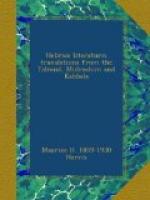When two women are seen sitting on opposite sides of a cross road facing each other, it is to be presumed that they are up to witchcraft and contemplate mischief. What in that case must you do? Go by another road, if there is one, and if not, with a companion, should such turn up, passing the crones arm-in-arm with him; but should there be no other road and no other man, then walk straight on repeating the counter-charm, as you pass them—
Agrath is to Asia gone,
And Blussia’s killed in battle.
P’sachim, fol. 111, col. 2.
Agrath and Blussia are two
Amazons well known to those familiar
with Rabbinic demonology.
“If Mordecai, before whom thou hast began to fall, be of the seed of the Jews, expect not to prevail against him, but thou shalt fall” (Esth. vi. 13). Wherefore these two fallings? They told Haman, saying, “This nation is likened to the dust, and is also likened to the stars; when they are down, they are down even to the dust, but when they begin to rise, they rise to the stars.”
Meggillah, fol. 16, col. 1.
If any two disciples of the wise, dwelling in the same city, have a difference respecting the Halachah, let them remember what Scripture denounces against them, “And also I gave them statutes that are not good, and judgments by which they shall not live” (Ezek. xx. 25).
Ibid., fol. 32, col. 1.
If a man espouse one of two sisters, and does not know which he has espoused, he must give both a bill of divorce. If two men espouse two sisters, and neither of them know which he has espoused, then each man must give two bills of divorce, one to each woman.
Yevamoth, fol. 23, col. 2.
There is a time coming (i.e., in the days of the Messiah), when a grain of wheat will be as large as the two kidneys of the great ox.
Kethuboth, fol. 111, col. 1.
According to a recent discovery, which has been confirmed by subsequent observation and experiment, wheat is a development by cultivation of the tiny grain of the AEgilops ovata, a sort of grass; but we are indebted to Rabbinic lore for the curious information that before the Fall of man wheat grew upon a tree whose trunk looked like gold, its branches like silver, and its leaves like so many emeralds. The wheat ears themselves were as red as rubies, and each bore five sparkling grains as white as snow, as sweet as honey, and as fragrant as musk. At first the grains were as big as an ostrich’s egg, but in the time of Enoch they diminished to the size of a goose’s egg, and in Elijah’s to that of a hen, while at the commencement of the common era, they shrank so small as not to be larger than grapes, according to a law the inverse of the order of nature. Rabbi Yehudah (Sanhedrin, fol. 70, col. 1) says that wheat was the forbidden fruit. Hence probably the degeneracy.
Of two that quarrel, the one that first gives in shows the nobler nature.




